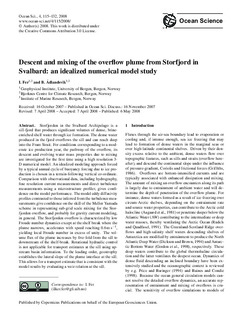Descent and mixing of the overflow plume from Storfjord in Svalbard: an idealized numerical model study
Original version
Fer, I. and Ådlandsvik, B.: Descent and mixing of the overflow plume from Storfjord in Svalbard: an idealized numerical model study, Ocean Sci., 4, 115-132, 2008.Abstract
Storfjorden in the Svalbard Archipelago is a sill-fjord that produces significant volumes of dense, brine-enriched shelf water through ice formation. The dense water produced in the fjord overflows the sill and can reach deep into the Fram Strait. For conditions corresponding to a moderate ice production year, the pathway of the overflow, its descent and evolving water mass properties due to mixing are investigated for the first time using a high resolution 3-D numerical model. An idealized modeling approach forced by a typical annual cycle of buoyancy forcing due to ice production is chosen in a terrain-following vertical co-ordinate. Comparison with observational data, including hydrography, fine resolution current measurements and direct turbulence measurements using a microstructure profiler, gives confidence on the model performance. The model eddy diffusivity profiles contrasted to those inferred from the turbulence measurements give confidence on the skill of the Mellor Yamada scheme in representing sub-grid scale mixing for the Storfjorden overflow, and probably for gravity current modeling, in general. The Storfjorden overflow is characterized by low Froude number dynamics except at the shelf break where the plume narrows, accelerates with speed reaching 0.6 m s−1, yielding local Froude number in excess of unity. The volume flux of the plume increases by five-fold from the sill to downstream of the shelf-break. Rotational hydraulic control is not applicable for transport estimates at the sill using upstream basin information. To the leading order, geostrophy establishes the lateral slope of the plume interface at the sill. This allows for a transport estimate that is consistent with the model results by evaluating a weir relation at the sill.
